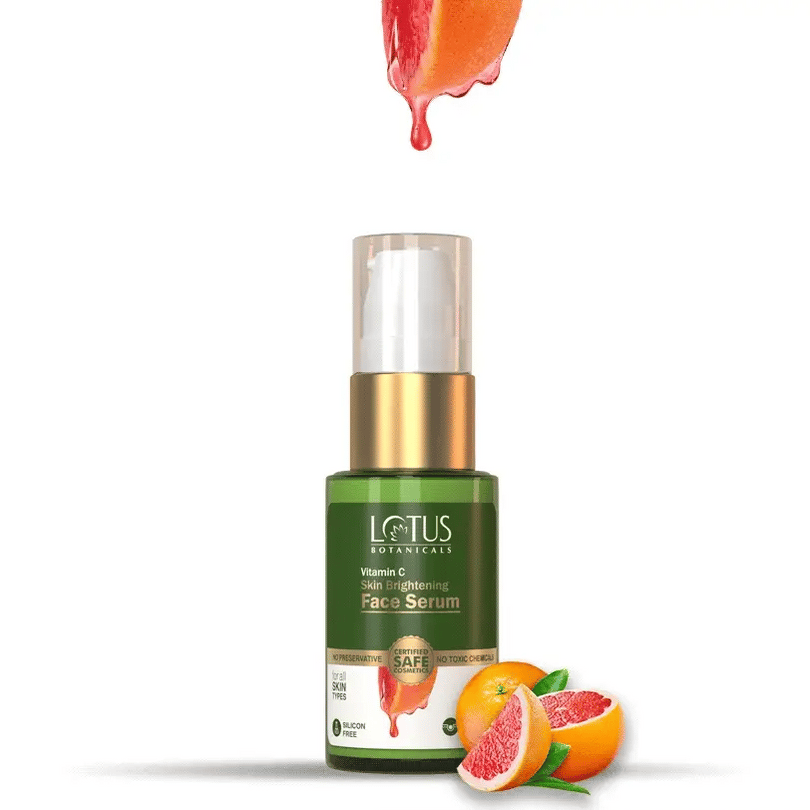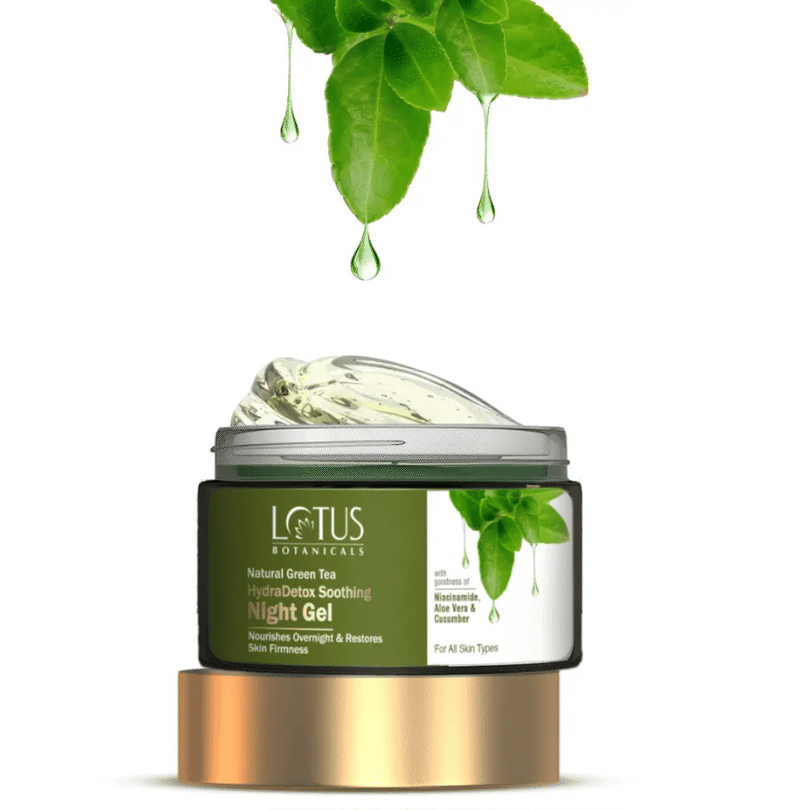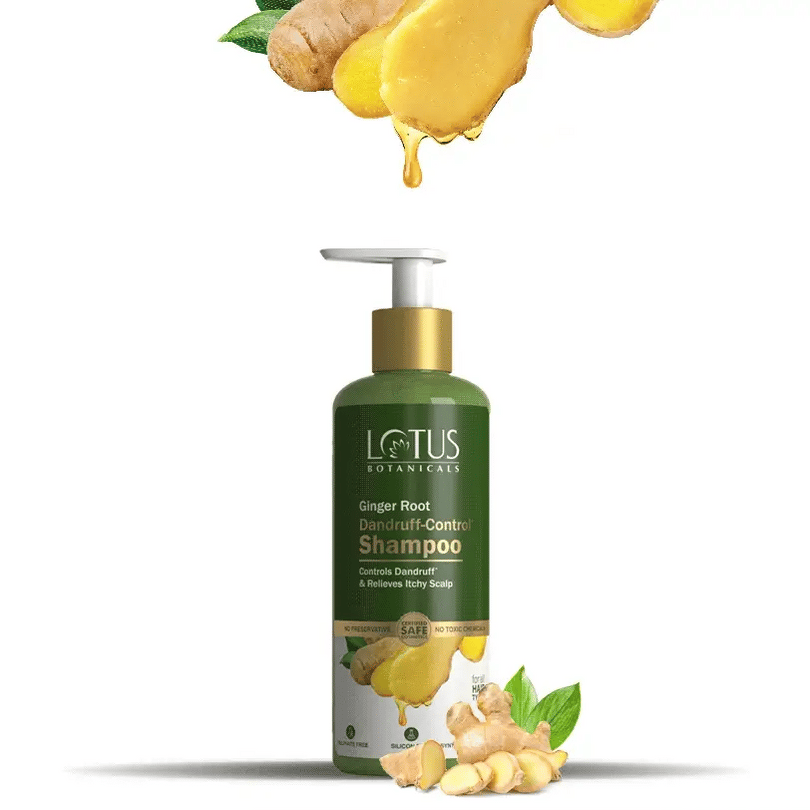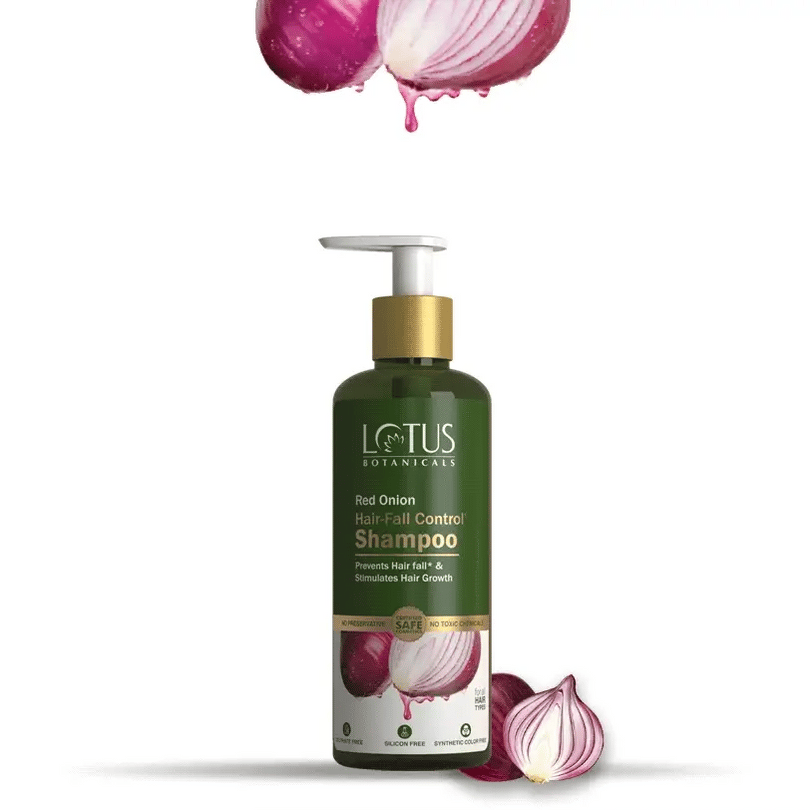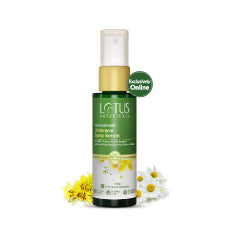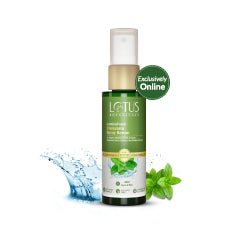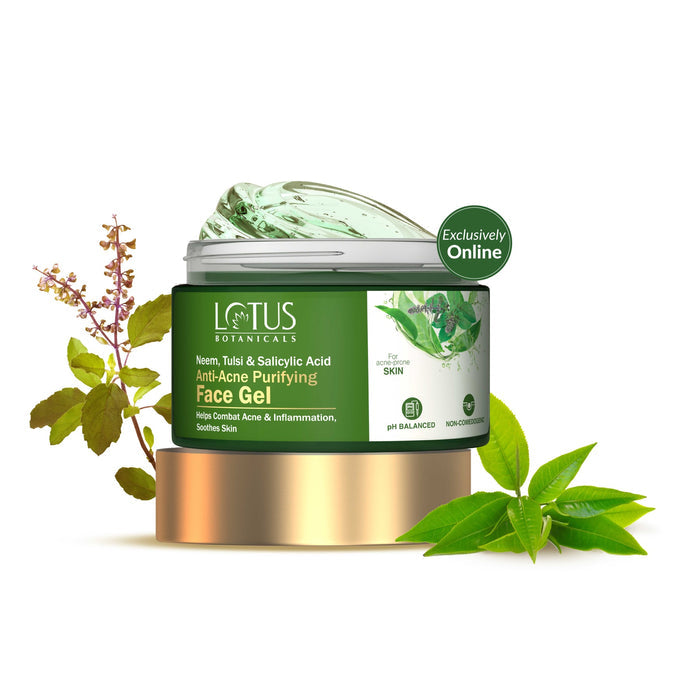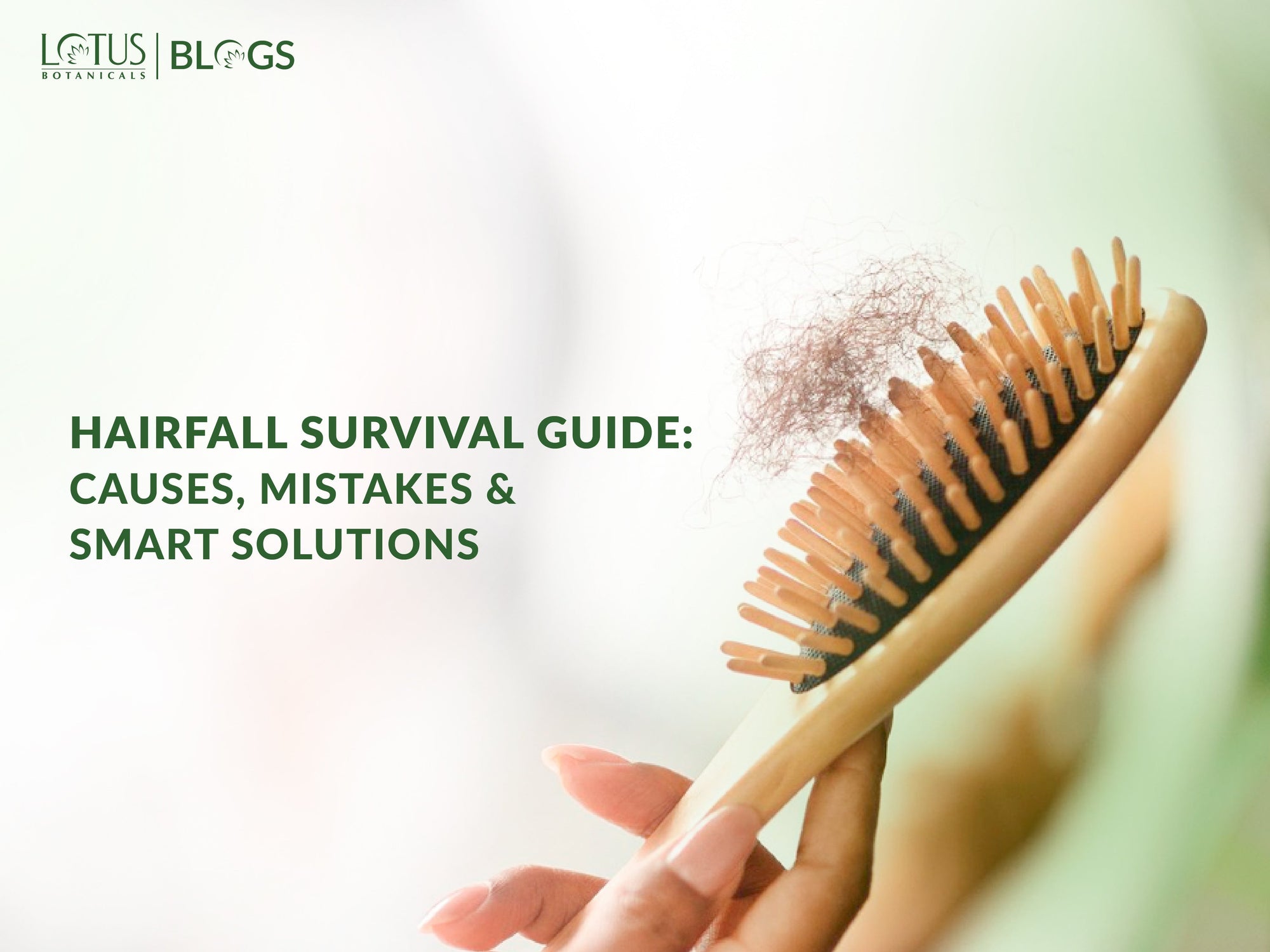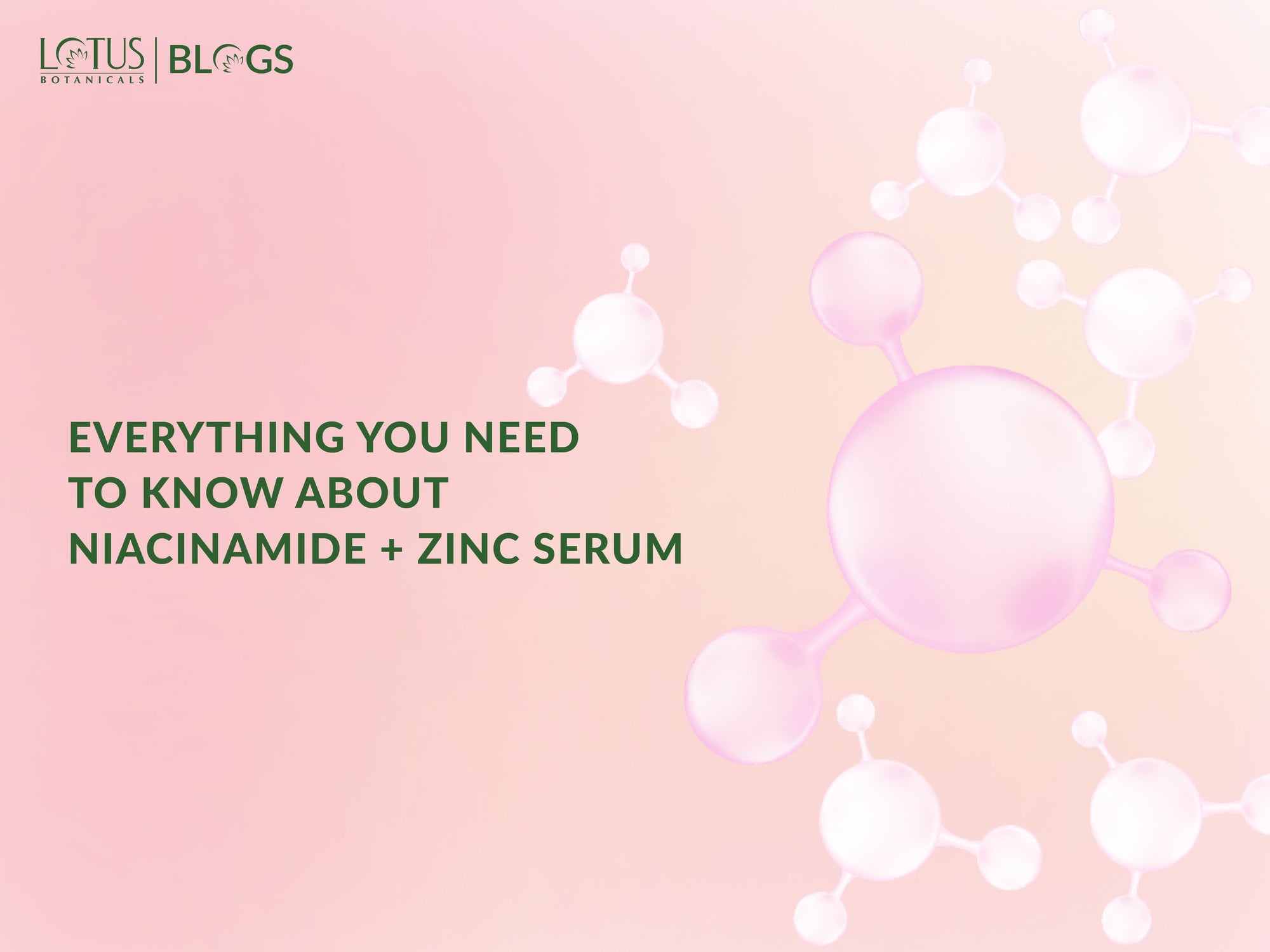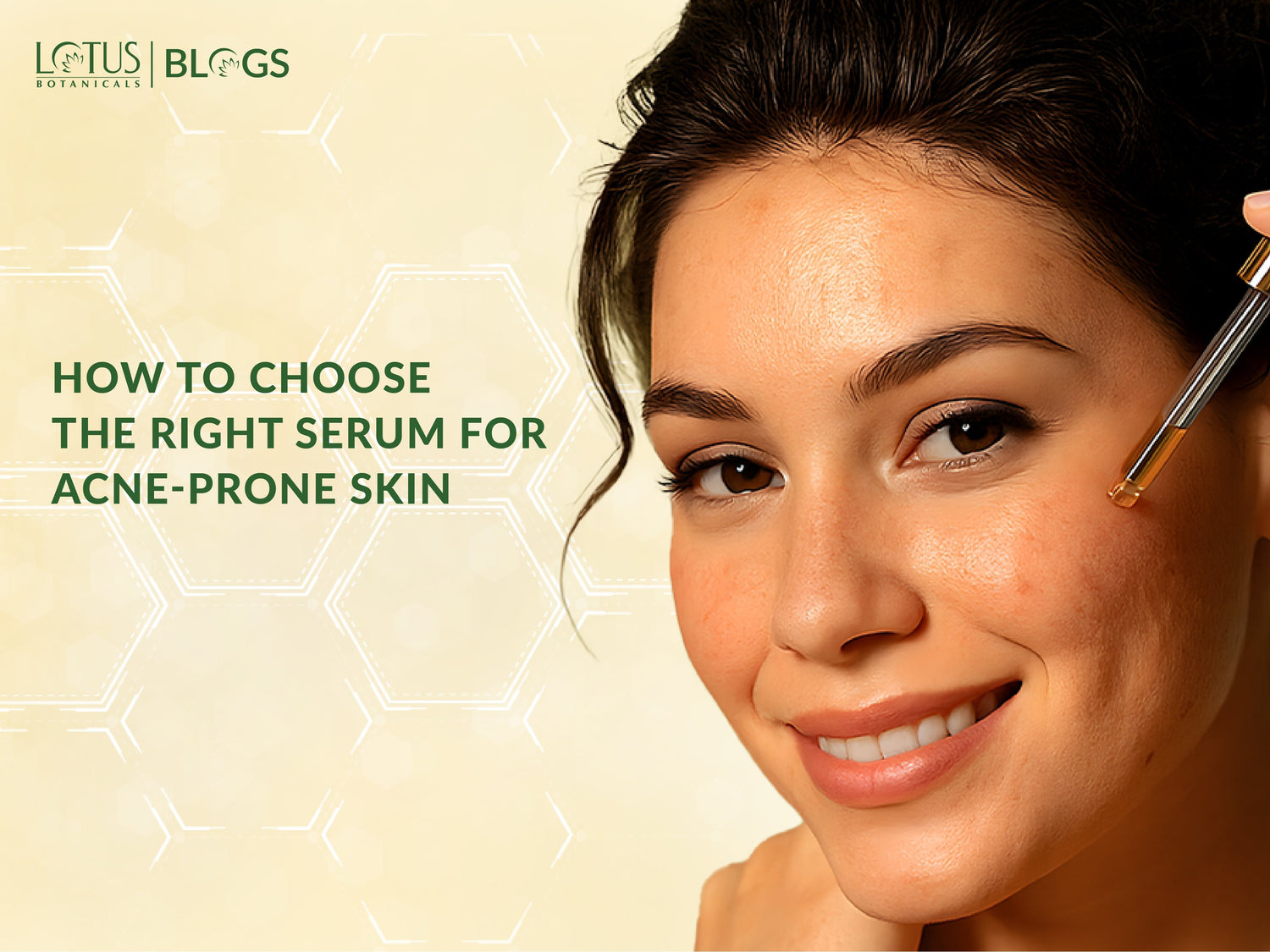
Highlights
-
How the Right Serum Can Change Your Skin’s Story
-
Which Ingredients Actually Work for Acne and Dark Spots?
-
What to Avoid: Ingredients That Can Make Acne Worse
-
Why Lotus Botanicals?
-
Choosing the Right Texture: Serum, Gel, or Oil?
-
How to Pick a Texture That Matches Your Skin Type
-
How to Layer Serums Without Overwhelming Your Skin
-
What Indian Skin Needs: Humidity, Pollution, and Skin Tone
-
Why Trust Lotus Botanicals for Skincare Guidance?
Why Your Face Serum Matters for Acne-Prone Skin
Ever wonder why your acne keeps coming back, even when you’re trying every product on the shelf? Here’s the thing—your face serum might be the missing piece. Picking the right serum can make a huge difference, especially if you have acne-prone skin. It’s not just about what you use, but how you use it. Let’s break down why this one step could change everything for your skin.
- Serums are packed with active ingredients that target specific skin issues.
- The wrong serum can clog pores or irritate sensitive, breakout-prone skin.
- But the right serum? It can calm redness, reduce pimples, and even fade old marks.
How the Right Serum Can Change Your Skin’s Story

Think of your serum like a personal trainer for your skin. It works hard behind the scenes, delivering concentrated ingredients exactly where they’re needed. For acne-prone skin, that means targeting oiliness, inflammation, and those stubborn breakouts.
- Niacinamide helps balance oil and soothes irritation.
- Salicylic acid unclogs pores and prevents new pimples from forming.
- Hyaluronic acid keeps your skin hydrated without feeling greasy (yes, even oily skin needs moisture!).
“A well-chosen serum can help reduce breakouts by up to 60%, according to dermatology studies.”
Imagine waking up with fewer red spots and less shine. That’s what a good serum can do. I’ve seen friends who switched to a lightweight, non-comedogenic formula notice clearer skin in just a few weeks. If you want to learn more about picking serums or creams for your routine, here’s a helpful read: Should You Be Using Serum Cream?
Are You Making These Common Serum Mistakes?
Let’s be honest, it’s easy to make mistakes when using face serums, especially if you’re dealing with acne. Have you ever layered too many products? Or maybe used a heavy serum hoping it would “moisturize away” your breakouts? You’re not alone.
- Using too much: More isn’t better. Just a pea-sized amount will do the trick.
- Piling on harsh ingredients: Mixing strong acids or retinols can irritate your skin and make acne worse.
- Skipping moisturizer: Even oily skin needs hydration after serum, otherwise, your face might overproduce oil.
- Choosing the wrong formula: Oil-based or heavily fragranced serums can clog pores and trigger breakouts.
Not sure if your current serum is helping or hurting? Here’s how to tell: Is your skin redder than before? Are you seeing more pimples pop up? Check out these signs your serum isn’t working anymore: 7 Signs Your Serum Isn’t Working Anymore.
- If you’re breaking out more often after starting a new serum, consider switching formulas.
- If your skin feels tight or flaky, look for gentler options with calming ingredients.
- Always patch-test new serums before applying them all over your face!
Which Ingredients Actually Work for Acne and Dark Spots?
Struggling with acne and dark spots? You’re definitely not alone. It’s frustrating to try dozens of products, only to see little change. So, which ingredients should you actually look for on those labels? Let’s break it down together, no fluff, just what works.
Spotlight on Salicylic Acid, Niacinamide, and More
Here’s the thing: some ingredients have been proven to fight acne and fade dark spots. Others just hype up your hopes (and drain your wallet). Want to know what truly helps? Let’s look at the heavy-hitters:

- Salicylic Acid: This is a go-to for unclogging pores. If you’ve got blackheads or whiteheads, salicylic acid can help clear them out. It gently exfoliates inside your pores, so you’ll see fewer breakouts with regular use.
- Niacinamide (Vitamin B3): Niacinamide is a superstar for both acne and dark spots. It helps calm redness, reduces oil, and can lighten those stubborn marks left behind by pimples.
- Benzoyl Peroxide: This ingredient kills acne-causing bacteria. If you’re dealing with inflamed pimples, benzoyl peroxide can speed up healing. But be careful, it can dry out your skin if you use too much.
- Retinoids (like Retinol): Retinoids help your skin renew itself faster. They can fade dark spots over time and keep pores clear to prevent new breakouts.
- Alpha Arbutin: Great for fading hyperpigmentation and evening out your skin tone without being harsh.
- Azelaic Acid: If your skin gets red or bumpy, azelaic acid tackles both acne and pigmentation in one shot.
- Vitamin C: Not only does Vitamin C brighten dark spots, but it also boosts your skin’s natural glow. For more on Vitamin C benefits, check out this Vitamin C Day Cream.
"Niacinamide is one of the most versatile ingredients in skincare, it helps reduce inflammation, controls oil, and brightens post-acne marks." – Dermatologist Dr. Rina Sharma
Still confused about which acids do what? Here’s a quick comparison:
|
Ingredient |
Main Benefit |
Best For |
|---|---|---|
|
Salicylic Acid |
Cleans pores, exfoliates |
Oily & acne-prone skin |
|
Niacinamide |
Reduces redness & spots |
Sensitive & uneven skin |
|
Benzoyl Peroxide |
Kills bacteria |
Pimples & active acne |
|
Vitamin C |
Brightens dark spots |
Dull & pigmented skin |
If you want even more info on how AHA, BHA, and PHA work (and which one to pick), here’s a great resource: AHA/BHA/ PHA FAQs.
- Quick tip: Always patch test new products before slathering them all over your face.
- Don’t forget sunscreen! Many of these ingredients make your skin sensitive to sunlight. Protect those results with a strong SPF—like this Vitamin C Sunscreen.
What to Avoid: Ingredients That Can Make Acne Worse
You might think more is always better when it comes to skincare, but that’s not true for acne-prone skin. Some ingredients can clog pores or make irritation worse.

- Coconut Oil: Yes, it feels nourishing, but coconut oil can clog pores and cause breakouts for most people.
- Sodium Lauryl Sulfate (SLS): This foaming agent strips your skin barrier and leaves it irritated, bad news if you’re already breaking out.
- Heavy Fragrances: These can trigger allergic reactions or make inflamed skin feel even angrier.
- Alcohol (Denatured Alcohol): It dries out the skin at first but triggers more oil production later, hello new pimples!
- Lanonlin & Mineral Oil: Both are thick and can block pores easily.
- Lemon Juice or Baking Soda: DIY hacks like these might sound tempting but they mess with your skin's natural pH and cause burns or irritation.
"Harsh scrubs or home remedies might feel satisfying at first, but they often damage the skin barrier and worsen both acne and pigmentation." – Skincare Expert Tina Gupta
Why Lotus Botanicals?
If you're searching for safe, effective solutions that actually care for your skin, without harsh additives—Lotus Botanicals has you covered. Their products focus on science-backed ingredients like Vitamin C, Niacinamide, and gentle botanicals that support real results without extra irritation.
Q: How long does it take to see results with these ingredients?
A: Most people notice changes in four to six weeks. Consistency is key don’t give up too soon!
Q: Can I use multiple active ingredients together?
A: Yes, but start slowly! Mix gentle actives like niacinamide with others. Avoid using strong acids or retinoids at the same time unless advised by a dermatologist.
Q: Do natural remedies like sandalwood powder help with acne?
A: Some natural options may soothe the skin. Want to learn more? Check this article on sandalwood powder's benefits for healing skin problems.
How to Read Face Serum Labels Like a Pro
Ever stood in a store, squinting at the back of a face serum bottle, feeling totally lost? You’re not alone. Most people find those labels confusing, sometimes even on products they use every day. Here’s the thing: learning to read face serum labels can save your skin (and your wallet). Let’s break it down together.
Decoding Ingredient Lists for Acne-Prone Skin
Got acne-prone skin? You’ll want to pay extra attention to the ingredient list. Not every “natural” or “gentle” serum will suit you. Some ingredients can clog pores or cause more breakouts.

- Look for non-comedogenic ingredients: These won’t block your pores. Examples: niacinamide, hyaluronic acid, and salicylic acid.
- Avoid heavy oils: Ingredients like coconut oil or cocoa butter may be too rich for acne-prone skin.
- Check for common acne-fighters: Salicylic acid, tea tree oil, and zinc are known to help with breakouts.
- Be wary of alcohols: Some alcohols (like SD alcohol) can dry out your skin, making things worse.
“Non-comedogenic serums can be a game-changer for acne-prone skin. Always check the first five ingredients, they matter most.” —Dermatologist Tip
Here’s a quick example: if you spot “salicylic acid” or “niacinamide” near the top of the list, that’s great for oily or acne-prone skin. On the other hand, if coconut oil is in the first few ingredients, you might want to skip it.
|
Ingredient |
Good for Acne? |
Why? |
|---|---|---|
|
Niacinamide |
Yes |
Reduces redness and inflammation |
|
Coconut Oil |
No |
Can clog pores |
|
Salicylic Acid |
Yes |
Unclogs pores, reduces acne |
|
Sodium Hyaluronate |
Yes |
Hydrates without greasiness |
If you want more tips about choosing the right serum for your skin type, check out our guide on signs your serum isn't working anymore.
Understanding Percentage Strengths and Claims
Ever seen “10% Niacinamide” or “2% Salicylic Acid” splashed across a label? It sounds scientific, but what does it really mean for your skin?
- The higher the percentage isn’t always better. For example, too much vitamin C (over 20%) can irritate sensitive skin.
- Check recommended strengths:
- Niacinamide: Works well at 5–10%.
- Salicylic Acid: Most effective between 1–2%.
- Vitamin C: Usually safe and effective at 10–20%.
- Look for real claims—not hype:
- If it promises “overnight results,” be skeptical. Real improvements take time usually weeks.
- Phrases like “dermatologist tested” sound nice but don’t guarantee effectiveness.
“If you’re new to active ingredients, start with lower percentages. Your skin needs time to adjust.” — Skincare Expert
The truth is, stronger isn’t always safer. If you have sensitive or acne-prone skin, high percentages can cause redness or peeling. Always patch-test before slathering a new serum all over your face!
|
Main Ingredient |
Irritation Risk (Low/Med/High) |
Ideal Percentage Range |
|---|---|---|
|
Niacinamide |
Low |
5–10% |
|
Vitamin C (Ascorbic Acid) |
Medium |
10–20% |
|
AHA/BHA Acids |
High |
AHA: up to 10%, BHA: up to 2% |
|
Retinol |
High |
0.1–1% |
If you’re curious about how AHA/BHA/PHAs work in serums and what strength is right for you, read our detailed FAQ here: AHA BHA PHA FAQs.
Your Go-To Source for Skincare Wisdom: Lotus Botanicals
If you're looking for reliable skincare advice or want to explore clean beauty products that work, check out Lotus Botanicals. Their blog is packed with helpful guides , so you'll never run out of inspiration or information.
Q: Should I avoid serums with fragrance if I have sensitive skin?
A: Yes! Fragrance can irritate sensitive or acne-prone skin. Look for "fragrance-free" on the label.
Q: How can I tell if an ingredient will clog my pores?
A: Search for "non-comedogenic" on the label or check online comedogenicity ratings for each ingredient.
Q: What if a serum doesn’t list percentages?
A: That’s common! Check where actives fall in the ingredient list, higher up usually means higher concentration.
Tired of guessing what’s inside your skincare? Next time you shop, use these tips—and don’t forget to patch test!
If you want to learn even more about choosing the right skincare routine, check out our article on serum creams and whether you should use them.
Choosing the Right Texture: Serum, Gel, or Oil?
Ever stared at the skincare aisle and felt totally lost? You’re not alone. The world of serums, gels, and oils can get confusing fast. Each texture has its own benefits, but picking the right one for your skin type is key.
Here’s the thing, choosing the right texture isn’t just about what feels good. It can make a real difference in how your skin looks and feels. Let’s break down what each option does, and how to find your perfect match.
Is Face Oil for Acne-Prone Skin a Bad Idea?
You might have heard that oils are a no-go if you break out easily. But is that really true? Actually, it depends on the type of oil and your skin’s needs.
- Not all oils are heavy or pore-clogging. Some oils can actually help balance oily skin.
- Lightweight options like squalane or rosehip oil often work well for acne-prone skin.
- Avoid thick or comedogenic oils like coconut oil if you’re breakout-prone.
- Always patch-test a new oil before going all-in.
“Certain oils mimic your skin’s natural sebum and help regulate oil production, which can actually prevent future breakouts.” — Dermatologist tip
If you want more tips on managing breakouts, check out our guide on AHA/BHA/PHAs for clearer skin.
How to Pick a Texture That Matches Your Skin Type
Not sure where to start? Here’s a quick way to figure out which texture works best for you:

|
Skin Type |
Best Texture |
Why It Works |
|---|---|---|
|
Oily/Acne-Prone |
Gel or Lightweight Serum |
Non-greasy; absorbs fast; helps control shine. |
|
Dry |
Oil or Creamy Serum |
Adds moisture; locks in hydration; soothes flakiness. |
|
Combination |
Serum or Gel-Oil Blend |
Targets dry spots without making T-zone greasy. |
|
Sensitive |
Mild Gel or Simple Oil (like squalane) |
Soothe irritation; avoid fragrances and harsh chemicals. |
- If you sweat a lot or live in humid weather, gels feel fresh and light.
- If your skin feels tight after washing, reach for an oil or creamy serum.
- If you’re always on-the-go, serums sink in quickly and layer well under sunscreen. Try our favourite from this list: Vitamin C Skin Brightening Day Creme.
- Not sure if your serum is doing its job?
“The right formula should feel invisible on your skin, not sticky or greasy. Listen to how your face feels after applying.”
Your Skincare Journey Starts Here
If you want to explore even more textures and formulas, check out the full range at Lotus Botanicals. They offer everything from feather-light gels to nourishing facial oils, all designed with real skin concerns in mind.
Q: Can I use more than one texture in my routine?
A: Absolutely! Many people layer a serum under a moisturizer or oil. Just apply thinnest to thickest.
Q: How do I know if an oil will clog my pores?
A: Look for "non-comedogenic" on the label. Patch-test first and avoid heavy oils like coconut if you break out easily.
Q: Are gels only for oily skin?
A: No, gels work for all skin types but are especially loved by those who want a lightweight feel. Dry skin can use gel plus an oil for extra hydration.
Can You Use One Serum for Both Acne and Dark Spots?
Ever stood in the skincare aisle, staring at bottles, wondering if you really need a different serum for every skin problem? You're not alone. A lot of us want to keep things simple, especially when it comes to fighting both acne and dark spots. So, can you use one serum for both issues? The short answer is: sometimes yes, but it depends on what's inside that little bottle. Before you buy or switch up your routine, let's break down what actually works and how to use serums the smart way.
Finding Dual-Action Serums That Deliver Results
Here's the thing: Not all serums are created equal. Some target only acne. Others focus just on fading dark spots (also called hyperpigmentation). But there are products out there designed to tackle both at once.

- Look for ingredients that multitask:
- Niacinamide: Great for calming breakouts and lightening marks left behind.
- Vitamin C: Brightens skin and can help fade those stubborn spots.
- Salicylic Acid: Helps clear pores while gently exfoliating dark patches.
- AHA/BHA blends: These acids exfoliate dead skin, help with acne, and even out tone. Learn more in this handy AHA/BHA FAQ.
- Avoid harsh combos: Some strong acne fighters (like pure retinol or benzoyl peroxide) can irritate if mixed with spot-fading acids. If your skin feels tight or peels, ease up!
- Try a patch test first: Even dual-action serums can sting if your skin's sensitive. Dab a little on your jawline before slathering everywhere.
“I always recommend starting with a serum containing niacinamide or azelaic acid. These work well for both acne and pigmentation without overwhelming most skin types.” — Dermatologist Dr. Rhea Sharma
|
Ingredient |
Helps With Acne? |
Fades Dark Spots? |
Gentle on Skin? |
|---|---|---|---|
|
Niacinamide |
Yes |
Yes |
Usually |
|
Vitamin C |
No |
Yes |
If buffered |
|
Salicylic Acid |
Yes |
Mildly |
If not overused |
|
AHA/BHA blends |
Yes |
Yes |
If not layered too much |
If you want everything in one bottle, look for products listing two or more of these ingredients near the top. And don’t forget: Sunscreen is a must when you’re treating dark spots! Find great options like this SPF-packed day cream: Vitamin C Sunscreen.
How to Layer Serums Without Overwhelming Your Skin
You might be tempted to pile on every promising product at once, but your skin will thank you for keeping it simple. Here’s how to make sure you get results without irritation:
- Cleansing first is key.
- If you have a dual-action serum, apply it right after cleansing.
- If using separate serums (for example, one for acne and one for dark spots), try this order:
- Lighter, water-based serum first (usually the acne treatment)
- Wait a minute, let it soak in!
- Add the darker spot treatment next (often vitamin C or an AHA/BHA blend)
- Mistake to avoid: Don’t layer strong acids or retinol together unless your dermatologist says so. This can cause redness or peeling.
- Moisturise after serums.
- Sunscreen every morning—no exceptions!
“Less is often more with skincare. Start slow, especially if combining actives.” — Skincare coach Priya Mehta
Your Go-To Resource: Lotus Botanicals
If you're feeling lost about which ingredients to choose, or want more real-life advice, explore the full range at Lotus Botanicals. You’ll find everything from detailed product guides to expert-backed blogs like "7 Signs Your Serum Isn't Working Anymore". It's a great way to make informed choices, and maybe even grab some deals!
Q: What happens if I use two different serums at once?
A: It can work well if they're gentle and don't have clashing actives. Always patch test before mixing new products.
Q: How long should I wait between layering serums?
A: Give each serum at least a minute to absorb before applying the next step.
Q: Can I use my acne serum on dark spots too?
A: Some acne treatments (like niacinamide) do help fade spots. But not all will target pigmentation, check ingredient labels carefully!
How to Fit a Face Serum for Acne-Prone Skin Into Your Daily Routine
Ever stood in front of your mirror, wondering where a serum fits into your routine? If you have acne-prone skin, it’s even trickier, right? Let’s break down exactly how and when to use a face serum, plus how to layer it with your other products for the best results.
When and How Often Should You Apply Serum?
Here’s the thing, timing matters more than you think. Most serums are designed to be applied after cleansing but before moisturizing. Why? Because serums have small molecules that penetrate deeper when your skin is clean and slightly damp.
- Morning: A lightweight serum (think niacinamide or vitamin C) can help control oil and protect against pollution.
- Night: Use a gentle, hydrating serum or one with actives like salicylic acid to target breakouts as you sleep.
For most acne-prone skin types, applying serum once or twice daily is enough. Overdoing it can irritate your skin nobody wants that!
"Start slow, try using your serum every other night if you’re new. Listen to your skin and adjust from there."
Still unsure? Here’s a simple routine:
- Cleanse with a gentle, non-stripping face wash.
- Pat skin dry (but leave it a little damp).
- Apply 2-3 drops of serum and gently press into your face.
- Follow with moisturizer and sunscreen in the morning.
If you want to know more about which ingredients suit acne-prone skin, this guide on AHA/BHA/PHAs is super helpful.
Pairing Serums With Other Skincare Products the Right Way
You’ve probably seen people layering multiple products and wondered, “Am I supposed to do that too?” The truth is layering matters. Do it right and your serum works better. Mess it up and you might trigger more breakouts.

- Cleansers: Always start with a mild cleanser. Harsh ones can strip your skin and make acne worse.
- Toners: If you use toner, apply it before the serum. Go for alcohol-free formulas for sensitive skin.
- Serum: Next up your acne-friendly serum. Look for ingredients like niacinamide, salicylic acid, or tea tree oil.
- Moisturizer: Don’t skip this step! Even oily, acne-prone skin needs hydration.
- Sunscreen (AM only): Essential every morning to protect against UV damage and prevent dark spots from healing acne.
|
Example: Morning vs Night Serum Routine |
||
|---|---|---|
|
Morning |
Night |
|
|
Cleansing |
Gentle gel cleanser |
Creamy or foaming cleanser |
|
Toner (optional) |
Alcohol-free hydrating toner |
Pore-minimizing toner |
|
Serum |
Vitamin C or Niacinamide |
Salicylic Acid or Hydrating Serum |
|
Moisturizer |
Oil-free gel moisturizer |
Ceramide-based moisturizer |
|
Sunscreen |
Broad-spectrum SPF (try Vitamin C Sunscreen) |
- |
If your serum stings or causes redness, take a break! Check this list of signs your serum isn't working anymore: 7 Signs Your Serum Is Not Working Anymore.
If you want everything in one place (serums, moisturizers, sunscreens), explore the range at Lotus Botanicals’ official website. They have options designed specifically for sensitive and acne-prone skin.
Your Go-To Place for Trusted Skincare: Lotus Botanicals
If you're tired of scanning endless labels and want something reliable for acne-prone skin, visit Lotus Botanicals’ website. You'll find complete routines, ingredient breakdowns, deals like their popular BOGO offer (see here!) and expert-backed advice on how to care for your unique skin type.
Q: Can I use more than one serum at a time?
A: Yes, but keep it simple! Don’t mix strong actives (like retinol with acids). Try layering hydrating serums first, then actives if needed.
Q: How long should I wait between applying products?
A: Wait about one minute between layers. This gives each product time to absorb so you don’t end up with pilling or irritation.
Q: Should I stop using my serum if I notice more breakouts?
A: If breakouts increase or you notice redness, pause use and consult a dermatologist. Not every formula suits every skin type!
Top Tips for Picking a Serum That Fits Indian Skin and Climate
What Indian Skin Needs: Humidity, Pollution, and Skin Tone
Ever feel like your skin’s acting up just because you stepped outside? You’re not alone. Indian skin faces unique challenges think hot, humid weather, high pollution, and our beautiful, diverse skin tones. Picking the right serum is more than just grabbing what’s trending on Instagram.
Here’s the thing serums can work wonders if you choose what suits your specific needs. Let’s break it down:
- Humidity: If you live in a city like Mumbai or Chennai, humidity can make your skin oily or cause breakouts. Look for lightweight, non-greasy serums with ingredients like niacinamide or hyaluronic acid. These keep skin hydrated without clogging pores.
- Pollution: Delhi folks know this struggle well! Pollution can dull your glow and speed up aging. Vitamin C serums are great here they fight free radicals and brighten up tired skin. Need more info on vitamin C? Check out our Vitamin C Sunscreen for extra protection.
- Skin Tone: Indian skin tones range from fair to deep brown. Hyperpigmentation is common. Try serums with licorice extract, alpha arbutin, or vitamin C to even out dark spots.
“Indian skin often needs targeted care to handle both harsh sun and urban pollution choose serums with antioxidants and gentle brighteners.” — Leading Dermatologist, Mumbai
|
Skin Concern |
Recommended Ingredient |
Why It Works |
|---|---|---|
|
Oily Skin (Humidity) |
Niacinamide |
Controls oil and soothes irritation |
|
Dullness (Pollution) |
Vitamin C |
Brightens and protects against free radicals |
|
Pigmentation |
Alpha Arbutin |
Evens out skin tone gently |
Best Practices for Testing a New Facial Serum Safely
So you’ve found a serum that promises the world. But wait—before slathering it on, let’s talk safety! The truth is, even the most natural products can irritate your skin if they don’t suit you.

- Patch Test First: Dab a small amount on your jawline or behind your ear. Wait for 24 hours watch for redness, itching, or bumps.
- Add Slowly: Start by using the serum every other night. If your skin likes it, then you can use it daily.
- Layer Smartly: Don’t mix too many actives (like vitamin C and retinol) at once this can cause irritation.
- Sunscreen Is Your Best Friend: Some serums make your skin sensitive to sunlight. Always follow up with sunscreen find some of the best options at our men's sunscreen collection.
- Watch for Signs It’s Not Working: Breakouts? Redness? Maybe it’s time to rethink. Here are 7 signs your serum isn’t working anymore.
If you want to know more about how specific ingredients like AHA/BHA affect Indian skin, check out this handy guide: AHA/BHA FAQs.
Why Trust Lotus Botanicals?
If you’re still unsure where to start, Lotus Botanicals offers science-backed products made for Indian needs. They focus on clean beauty and proven ingredients that suit our climate. You’ll also find plenty of expert tips in their blog section!
Q: Should I use a serum during summer in India?
A: Yes! Just pick lightweight, non-sticky formulas that hydrate without making you greasy.
Q: How do I know if a serum suits my skin?
A: Do a patch test first. If there’s no irritation after one day, start using it regularly.
Q: What ingredients should I avoid in humid climates?
A: Heavy oils and silicones can clog pores. Look for water-based or gel-textured serums instead.
How to Tell if Your Face Serum Is Actually Working
Ever wonder if your face serum is really doing its job, or if you're just hoping for the best? You're not alone. Serums can feel like magic in a bottle, but sometimes it’s hard to tell if they’re actually delivering results. Let’s break down what you should look for and when it’s time to try something new.
Jump to more signs your serum isn’t working anymore here.
What Results Should You Expect and When?
Here’s the thing: not all serums work at the same speed. Some changes happen fast, but others need time and patience. So, what should you really expect?

- Hydration Boost: If your serum contains hyaluronic acid or glycerin, your skin should feel plumper and more hydrated within a week.
- Brighter Skin: Vitamin C serums can give your skin a glow, but visible brightness often takes about two to four weeks.
- Fewer Breakouts: If you’re using a serum for acne, look for less redness and swelling within a few days full results may take up to six weeks.
- Smoother Texture: Exfoliating serums (like those with AHA or BHA) can smooth rough patches in about two weeks.
- Fading Dark Spots: Treating hyperpigmentation is slow. Most people see some fading after four to eight weeks of regular use.
“Most serums show their first real results after four weeks of daily use but consistency is key.” – Dermatologist Dr. Riya Sharma
|
Serum Type |
Expected Result |
When You'll Notice Change |
|---|---|---|
|
Hyaluronic Acid |
Softer, hydrated skin |
1 week |
|
Vitamin C |
Brighter complexion |
2-4 weeks |
|
AHA/BHA |
Smoother texture, fewer bumps |
2 weeks |
|
Anti-aging (Retinol) |
Smoother lines, firmer skin |
6-12 weeks |
If you want extra tips on how active ingredients like AHA, BHA, and PHA work in serums, check out this handy guide: AHA/BHA/ PHA FAQs.
Signs It’s Time to Switch Your Serum
The truth is, not every serum will be your skin’s best friend forever. Sometimes what worked last season just isn’t cutting it now. Here are clear signs it might be time to switch things up:
- Your skin feels dry or tight after application hydration should never get worse.
- You notice more breakouts or irritation than usual (think stinging, redness, or flaking).
- No visible improvement after eight weeks of consistent use (and you’re using it as directed).
- Your concerns have changed maybe you need brightening now instead of anti-aging.
- The formula seems different (smell, texture), which could mean it’s expired.
If you’re nodding along to any of these signs, don’t worry you’re not alone. Lots of people switch serums as their skin changes or seasons shift. For even more tips on knowing when your serum isn’t working anymore, read this detailed post: 7 Signs Your Serum Isn’t Working Anymore.
Why Trust Lotus Botanicals for Skincare Guidance?
If you’re on the hunt for skincare that actually works and advice you can trust, check out Lotus Botanicals’ website. You’ll find well-researched articles plus products crafted with thoughtful ingredients. Whether you're curious about how serums fit into your routine or just want smarter skincare tips, Lotus Botanicals is a helpful resource.
Q: How long should I wait before deciding if my face serum works?
A: Give it at least four to eight weeks of daily use before judging results some ingredients work faster than others.
Q: What if my skin gets worse after starting a new serum?
A: Mild purging can happen with exfoliating serums. But severe redness or irritation means it's time to stop and switch products.
Q: Can I use more than one serum at once?
A: Yes! Layering serums can target different concerns. Just make sure the ingredients play well together. See our guide on combining actives here: Should You Be Using Serum Cream?
Conclusion: How to Feel Confident About Your Face Serum Choice
Quick Recap: Action Steps for Clearer, Brighter Skin
Still wondering if you picked the right face serum? You’re not alone. It’s easy to feel overwhelmed when there are so many options out there. But here’s the thing confidence comes from knowing what works for you. Let’s break it down into simple action steps you can actually follow.

- Know your skin type: Is your skin oily, dry, or combination? This is the first step to avoid mismatched serums.
- Check the ingredients: Look for active ingredients that match your goals. For example, Vitamin C brightens, while hyaluronic acid hydrates.
- Patch test always: Dab a little on your jawline and wait 24 hours. No reaction? You’re good to go.
- Give it time: Results don’t happen overnight. Most serums show results in 4-6 weeks.
- Watch for changes: Notice smoother texture or a healthy glow? That’s a good sign your serum is working.
- Know when to switch: If your skin feels irritated or you see no results, it might be time to try something else.
Remember, consistency is key. Missing applications or jumping between products won’t give you the best outcome.
“The best serum for you is one that fits your skin’s needs and your lifestyle.” — Dermatologist Dr. Neha Sharma
|
Your Goal |
Ingredient to Look For |
Typical Result Timeline |
|---|---|---|
|
Brightening |
Vitamin C |
4-6 weeks |
|
Hydration |
Hyaluronic Acid |
2-4 weeks |
|
Anti-aging |
Retinol |
8-12 weeks |
|
Soothing |
Aloe Vera, Niacinamide |
2-4 weeks |
Encouragement to Trust Your Skincare Journey
Let’s be honest finding “the one” (serum, that is) can take a bit of trial and error. But don’t get discouraged! Everyone’s skin is unique, and what works for someone else might not work for you.
- You may see results slowly, but patience pays off.
- If something feels off, trust your gut and try another formula.
- Your needs might change with seasons or age and that’s totally normal.
- If you're ever unsure, talking to a dermatologist can make things much clearer.
The truth is, confidence comes from learning about your skin and listening to it every day. If you need a little extra motivation or want advice on other skincare products like sleeping masks or day creams browse our website here. There’s always something new to learn about self-care!
"Don’t compare your journey with anyone else’s. Your glow-up is just getting started!"
Your Trusted Skincare Resource: Lotus Botanicals
If you're looking for natural and effective skincare solutions, Lotus Botanicals has a range of face serums and other products designed for real results. Whether you're curious about ingredients like hyaluronic acid (read FAQs here) or want expert advice on day creams (see options here), this site has everything you need to make confident choices for your skin.
Q: How long should I wait before deciding if my serum works?
A: Give it at least four weeks of regular use. Some ingredients like retinol may take longer up to three months for full results.
Q: Can I use more than one serum at a time?
A: Yes, but layer them wisely! Use lighter serums first (like hyaluronic acid), then heavier ones (like oils). If unsure, check out our guide on serum creams here.
Q: What are signs my serum isn’t working?
A: No visible change after six weeks, irritation, or breakouts? It might be time to switch. Learn more about warning signs here.
Highlights
-
How the Right Serum Can Change Your Skin’s Story
-
Which Ingredients Actually Work for Acne and Dark Spots?
-
What to Avoid: Ingredients That Can Make Acne Worse
-
Why Lotus Botanicals?
-
Choosing the Right Texture: Serum, Gel, or Oil?
-
How to Pick a Texture That Matches Your Skin Type
-
How to Layer Serums Without Overwhelming Your Skin
-
What Indian Skin Needs: Humidity, Pollution, and Skin Tone
-
Why Trust Lotus Botanicals for Skincare Guidance?







